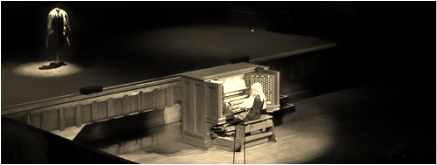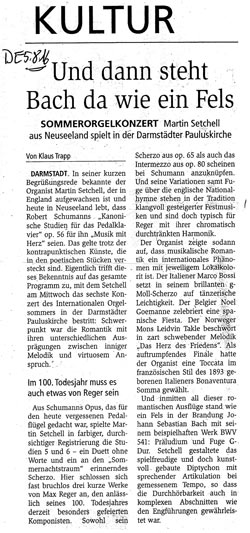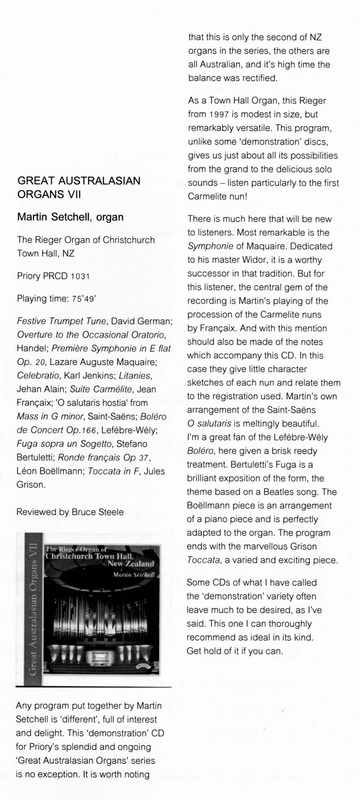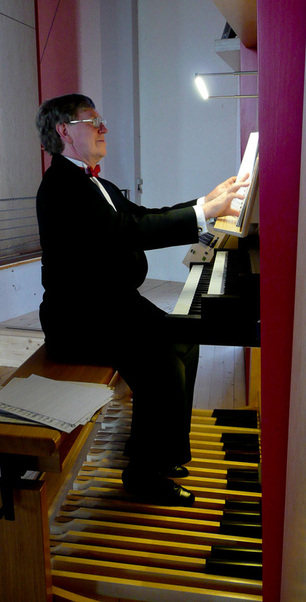Reviews of CDs, Concerts, and musicFrom Middle-C.org, by Peter Mechen
This recording, “Resounding Aftershocks” broke an eight-year silence for the Christchurch Town Hall Rieger organ which followed the catastrophic 2011 earthquakes, and, as befitted the occasion, celebrated the instrument’s return to full prowess in heady fashion! Organist Martin Setchell’s long-established brilliance and elan as a performer is here demonstrated to the utmost thanks to the skills and expertise of the disc’s sound engineer Mike Clayton, capturing the occasion most resplendently. Purely as a sound-spectacle it’s a thrilling experience; and the mix of well-known (Widor’s ubiquitous “Toccata”), sure-fire crowd-pleasers (Guilmant’s Handelian “Grand Choeur”), ear-tickling discoveries and gentler/more humourful moments (Reynaldo Hahn’s “A Chloris” and Denis Bédard’s “Cats at Play”) and out-and-out celebratory free-for-alls (Mons Leidvin Takle’s “Celebration” – a riot of sounds, suitably “cheesy” in places and all the more enjoyable and festive for that), suggests a time for uninhibited listening-pleasure in a variety of shapes and forms, if ever there was one!
Continuing the “resounding” ambiences are JS Bach’s Prelude In G Major BBWV 541 closely followed by the Guilmant “Grand Choeur in D”, suitably subtitled “a la Handel”! Contrasts come with Setchell’s arrangement of Reyaldo Hahn’s son “A Chloris”, before we are thrown back into sterner stuff with Noël Goermanne’s energetic, if somewhat dour, “El Dia de Fiesta” (impressive in its own way, but I think I would have rather been somewhere with a bit more cheerful an aspect!) Thank goodness for Enrico Bossi’s mischievous Scherzo in G minor immediately afterwards, with its charming antiphonal-like echo effects, and piquant mood-changes wrought by some gorgeously-varied registrations. Bonaventura Somma’s ebullient Toccata in A undoubtedly echoes the sound-world of THE more famous Widor, but fascinates as an engaging variant, all the same, as does Marcel Languetuit’s Toccata in D Major, the textures also remarkably similar to Widor’s, even if the trajectories are differently calibrated! Incidentally, I’m sure the dedicatee to this piece, Albert Dupré, was actually the father of organist MARCEL Dupré, and not “Maurice”, as commented on in the booklet notes! Louis Vierne’s Romance from his Fourth Organ Symphony straightaway haunted the ear like no other track heard thus far, with an excerpt that seemed to capture the essence of the instrument’s soul more deeply and ambiently than anything else on the CD – a deep well of feeling in the midst of so many sparkling, sunlit fountains and cascading waterfalls. Vierne wrote the work in 1914, in the shadow cast by the oncoming European hostilities, the piece’s darker, more agitated middle section reflecting these tensions and uncertainties in contrast to the serenities of the outer sequences of the music. Max Reger’s “Variations and Fugue on God Save the Queen” (somewhat oddly written after the death of Queen Victoria in 1901) was included by Setchell to pay due respect to Christchurch’sEnglish heritage, and to honour Queen Elizabeth II, now the British throne’s longest serving monarch. However ill-timed one might think the piece’s original provenance, there’s no doubt it all makes a rather gorgeous and resplendent noise, especially as the music works up to an undeniably sonorous climax! I had never heard of English composer Madeleine Dring, but her “Caribbean Dance” from 1959, as arranged by Setchell, has a lazily attractive rhythm, crunching some unexpectedly bluesy-plus harmonies at one point, before leading to a suitably insouciant conclusion. I loved the tremulous Voix humaine’s other-worldly sound in Louis James Alfred Lefébure-Wély’s Andante in F, a demonstration, incidentally, of one of two new stops “gained” by the refurbished instrument, the other being the Clarinette sound in the transcription of the Hahn song. The piece’s spacious serenity provides the utmost contrast to the opening tones of the long-awaited, tried-and-true favourite, Charles-Marie Widor’s arresting Toccata, from the Fifth of the composer’s organ symphonies, Setchell’s recording , here “lifted” without any signs of wear-and-tear from the organist’s 1997 MANU recording “Let the Pealing Organ Blow” as an appropriate “link” with the instrument’s history, one underlining the “return to life” of one of Christchurch’s most important cultural assets, and further reinforcing the inestimable qualitative value to the city of one of its most illustrious performers. "In every way, absolutely exceptional"Organ Concert by Martin Setchell
Christ Church Anglican Church Saturday September 30 at 2pm, 2018 (Reviewed by L.C.) An exceptionally well shaped programme was presented by concert organist Martin Setchell on the organ of Christ Church, Wickstead Street, last Saturday afternoon. Matching (or even surpassing) the quality of the programme itself, was the quality of playing by this brilliant international organist. The concert was in two distinct halves, the first of which took us on a journey through familiar musical styles but with less familiar pieces. Martin Setchell played these ‘classical’ works with brilliant clarity of touch, clean, measured and meaningful phrases and with lots of wonderful contrast. The clarity of the inner parts of his Bach fugue was such that I have never heard before on this organ. There were many in the audience who felt they had had their money’s worth by the end of the second item! The second half of the programme comprised six very modern pieces, all intriguing in their registrations and rhythms. Often dance-like and irregular, they entertained the enthusiastic audience by turning unexpected corners, contrasting unexpected sounds and confronting the listener with elements not usually associated with organ music. There were jazz and Latin American flavours to name but two. This was a concert of the very highest echelon. Technically, it was stunning. Martin Setchell played with an assured, absolutely accurate and wonderfully expressive style. It was brilliantly registered with interesting, effective and extremely well balanced sounds. At all times musical and meaningful. The audience was treated to a concert which was in every way, absolutely exceptional. Delights of Weingarten (08-08-2017)'Masterful show on Waiapu organ'Organ concert, by Martin Setchell
at Waiapu Cathedral, Remembrance Sunday, November 13, 2016 Reviewed by Alan Alexander (Hawke's Bay Today) Martin Setchell, international concert organist, provided a wonderfully entertaining programme on Remembrance Sunday that was flavoured with music appropriate to the occasion. Setchell, an Englishman by birth, opened the programme using the fanfare trumpet to present Gordon Jacob's arrangement of the English National Anthem. This was followed by Variations and Fugue on God Save the Queen. These variations, by German composer Reger, were, in fact, composed in 1901 to celebrate the reign of Queen Victoria. As a counterbalance, the second half of the programme commenced with the New Zealand National Anthem followed by A New Zealand Suite - Variations on God Defend New Zealand. This suite was specially written for, and dedicated to, Setchell by the Italian composer Grimoaldo Macchia. The six movements, delivered with gusto, used all the tonal resources of the organ and demonstrated the passion that Italians have for melody. The rest of the programme was a delightful mix of pipe organ music and well-known transcriptions. Bach's "great" Prelude and Fugue in G major was originally composed by Bach for an audition his son was preparing for. Setchell's presentation flowed beautifully without any registration changes. The transcriptions included Grainger's Handel in the Strand and Wagner's Pilgrim's Chorus from Tannhauser. The Handel was just a delight as it bounced around using the wonderful flute stops in the organ. The first half ended with another transcription, this being Elgar's well-known Pomp and Circumstance March No4 in G. The concert concluded with a typically French-styled toccata - Toccata in D by Marcel Lanquetuit, formerly organist at Rouen Cathedral. For the appreciative audience, Setchell's encore was another transcription - Trepak from Tchaikovsky's Nutcracker Suite. The concert was a masterful demonstration of just how capable the Waiapu instrument is for presenting both pipe organ and transcriptions of orchestral music.
"real artistry . . . it's fun listening to such splendid playing, meticulous and flawless . . ." Bruce Steele, review of Cardboard Capers CD, Organ Australia, Winter 2014 "Martin Setchell always comes to the party with creative CD titles and brilliant programming: a hallmark of his many CD projects. Martin makes full use of the built-in velocity sensitivity with subtle dynamic inflections which are stunning in such works as the Sugar Plum Fairy and Fauré's Sicilienne" Roy Tankersley, review of Cardboard Capers CD, Organz news (NZ), May 2014 "It was a real pleasure to have you grace the famed Tabernacle organ with your magnificent and professional musical capabilities. Your program was excellent and your skill and technique was impeccable." (Mormon Tabernacle, April, 2012) “… combining academic depth with dynamic flair and a rare and happy knack in selecting music that entertains as well as edifies” “. . . he is an impeccable stylist, with nimble fingers (and feet) and is clearly having a jolly good time as well” Zweites Konzert des „Orgelsommers“ in der Franziskus-Kirche, Pforzheim
Autor: Eckehard Uhlig, August 2014
Pforzheim. In der heutigen hektisch-digitalisierten Welt haben gerade die Orgel und ihr Klang im Kirchenraum die Macht, uns zur Ruhe und Sammlung zu bringen. Das durften die Besucher des zweiten Konzerts beim Pforzheimer Orgelsommer in der St.-Franziskus-Kirche erleben. Organist Martin Setchell aus Neuseeland hatte seine musikalische Schatztruhe mitgebracht, nämlich eigene Orgel-Bearbeitungen von Musikstücken, die von den Komponisten für andere Instrumente geschrieben worden waren. Zu den Preziosen gehörte die berühmte „Sicilienne“ aus Gabriel Faurés Bühnenmusik „Pelléas et Melisande“, eine elegant zarte, schmeichlerische Melodie. Auch das „Largo“ aus Johann Sebastian Bachs Violin-Doppelkonzert (BWV 1043) wurde von Setchell auf ähnliche Weise interpretiert, mit sinnlich weichen Flöten-Registerstimmen über Generalbass-Orgelpedal. Stimmungsvoll intim wirkte die Wiedergabe zweier Sätze aus Robert Schumanns „Kanonischen Studien für Pedalflügel“ (op. 56): In Nr. 4 (As-Dur) lösten sich die Melodielinien verschwimmend auf, in Nr. 5 (h-Moll) wurden die Akkorde scharf voneinander abgesetzt. In „Prélude et Fugue“ (op. 99/3) von Camille Saint-Saens schäumten Arpeggien-Folgen wie in einem rauschenden Klangfarben-Wasserfall. Technisch höchst versiert Überragend dabei die Virtuosität, mit der Setchell technisch schwierigste Passagen bewältigte – etwa in Jean Langlais’ „Cats“, einem lautmalerischen Katzen-Geschrei für Orgel. Spannend, wie man seine munter und flink über die drei Manuale huschenden Hände per Video-Übertragung beobachten konnte. Natürlich beherrschte der exzellente Organist auch die festliche, kraftvoll jubilierende Klangpracht der Orgel, was er in Kompositionen von Georg Friedrich Händel (Ouvertüre aus „Occasional Oratorio“), Alfred Hollins („A Trumpet Menuet“) oder Marcel Lanquetuit („Toccata in D-Dur“) zur Freude der Zuhörer unter Beweis stellte. From the Mühlacker Tagblatt, 07 August 2014, by Eva Filitz
Den Freunden des Mühlacker Orgelsommers ist Martin Setchell bereits vertraut. Konzertreisen führten den neuseeländischen Orgelvirtuosen mehrfach in die USA, nach Kanada, Australien und Europa. Nun saß er bereits zum dritten Mal am Orgel-Spieltisch in der Pauluskirche.
Mühlacker. Setchell muss sich während seiner vielen Tourneen durch die Kirchen der Welt immer wieder auf Orgeln verschiedenster Bauart einstellen, was allein schon eine Herausforderung ist, sollen die nachfolgenden Darbietungen doch stets den eigenen Erwartungen und denen seines Publikums genügen. Die neue Mönch-Orgel der Paulus-Kirche ist für den Kenner eher eine kleine Orgel, die ihm inzwischen nicht mehr fremd ist. „Ich spiele sehr gerne hier in Mühlacker“ sagte er und freute sich viele Bekannte und auch bereits Freunde wieder zu treffen. „Selten gehörte englische und französische Raritäten, gewürzt mit einer Spur britischen Humors werden von der Orgelempore herunter erklingen“, war in der Ankündigung zu lesen. Seinem Anspruch, Orgelmusik unterhaltsam zu gestalten, wurde Setchell voll gerecht, ohne dass er den Ernst und die Tiefe seines Vortrags vermissen ließ oder die Würde des Gotteshauses verletzte. Virtuos erfreute er das Publikum mit einem abwechslungsreichen Programm, das er persönlich unten im Kirchenschiff dem Publikum vorstellte, ehe er mit „Celebratio“, einem festlichen Orgelstück des zeitgenössischen walisischen Komponisten Karl Jenkins den Konzertabend eröffnete. 300 Jahre zurück ins Barockzeitalter griff er mit einer Hommage an den Großmeister der Orgelliteratur Johann Sebastian Bach mit der Originalwiedergabe des Chorals „Nun freut euch liebe Christen gemein“, überraschte dann mit drei weiteren Bach-Werken, jedoch in eigener Bearbeitung, darunter dem zweiten Satz aus dem „Doppelkonzert für zwei Violinen, BWV 1043“. Äußerst innig und berührend gestaltete er dieses „Largo“. Keine machtvollen orchestralen Orgelakkorde füllten den Raum. Weiche singende „Streicherklänge“ umfingen die Zuhörer. Es öffneten sich musische Weiten, in die man sich hineinträumen konnte, sich ganz der Musica hingeben oder sich gar darin verlieren konnte, stets auf sanfte Weise klar pointiert, ohne jede Gefühlsduselei. Wie gebannt lauschten die Zuhörer. „Er hat dieses Stück mit besonders viel Herz gespielt“, sagte später seine Frau Jenny. Sie begleitet ihren Mann auf den Konzertreisen und führt zuvor den Stift bei den Registrierungen. Mit zwei Schumann-Interpretationen folgte ein weiterer Klassiker, ehe mit facettenreichem Spiel Komponisten des 19.und 20.Jahrhunderts und der Gegenwart in den Vordergrund rückten. Bei „A Trumpet Minuet“ von Alfred Hollins muss sich neben der Orgel ein Trompeter versteckt haben, so authentisch war die Trompete zu hören. Doch mitnichten – der Virtuose am Orgeltisch wusste lediglich die passenden Register zu ziehen. Wenig später führte er seine Zuhörer ins pulsierende Leben einer belebten Shopping-Meile, in Noten festgehalten von Percy Grainger, einem amerikanischen Komponisten, und in der Bearbeitung von Setchell/Stockmeyer. Ein Prelude und eine Fuge des Franzosen Camille Saint-Saëns ließen die „Königin der Instrumente“ zur Abwechslung wieder einmal in „vollem Ornat“ auftreten, ehe eine heitere „Jig“ von John Gardner und eine jazzig angehauchte „Blues Toccata“ des Norwegers Mons Leidvin Takle den Schlusspunkt unter einen unkonventionellen Konzertabend setzten und die Zuhörer nun zu wahren Begeisterungsstürmen hinriss. Wohlgemerkt: erst am Ende des Konzertes und somit ohne die stimmige Atmosphäre nach jedem Stück zu „zerhacken“. Ergebnis der wohltuenden Zurückhaltung: ein Konzertgenuss von A bis Z, wie rundum zu hören war. Martin Setchell ist eine Größe unter den bekannten Orgelvirtuosen. Was ihn so ungemein sympathisch macht: Er ist bei all seinen internationalen Erfolgen und Auszeichnungen bodenständig geblieben. Ein Künstler zum Anfassen, dem man anmerkt, dass ihm das Plaudern auf Augenhöhe mit den Konzertbesuchern ein echtes Bedürfnis ist. Bei einem kleinen Imbiss mit Brezel und Orgelwein genossen viele Gäste diesen direkten Kontakt. Ein wichtiges Anliegen des Künstlers ist es, auf unterhaltsame Weise einem breiten Publikum Orgelmusik nahe zu bringen. Und er schafft es, mit seinen Interpretationen die „Königin der Instrumente“ ein wenig von ihrem Podest herunter zu holen und dem „Fußvolk“ nahe zu bringen. |
Reviews of Wedding March Extraordinaire:
"The march, which weaves in all the typical wedding music themes, makes a wonderful concert encore" [Kirchenmusik im Bistum Osnabrück 48/2015] "Setchell's intention not only to make the audience smile, but also to laugh, is guaranteed!" [Musica Sacra 6/2015] Great Australasian Organs VII CD
(Click on image to enlarge) Bach Transcriptions for Organ
"All are arranged very effectively - no unnecessary notes - for players at an 'intermediate' standard . . . most of these transcriptions could be very handy for weddings or funerals, as 'fillers', and as short but effective concert items . . . Setchell is a skilful arranger and the pieces would sound well on most church organs. His two-page introduction with notes on the pieces is authoritative and helpful. Highly recommended." - Bruce Steele, Organ Australia, Spring 2014 "There is a good balance of both reflective and rousing works, with pieces suitable for weddings, funerals, church services and concerts . . . Registration suggestions have been given, which provide enough direction while still allowing the organist to explore what is possible on their instrument. Across the board they are effectively transcribed, sitting nicely under the hands and feet, with enough compositional integrity for the beauty of the music to shine through. I have no hestiation in recommending this book to all organistst as a valuable addition to our repertoire." - Dominic Perissinotto, NZ organ News, November 14 A Purcell Organ Album
"Here is a splendid book with which to celebrate this anniversary year . . . There are inevitably a few warhorses, but there is so much which could well be unfamiliar that the book was for me a treasure house of new music. The 'Chaconne: Dance for Chinese Man and Woman', 'Rondeau' and 'Dance for the Fairies' all from The Fairy Queen were three which stood out. All the pieces lie comfortably under hands and feet, and will sound good on the smallest of instruments. They will grace all kinds of occasions: do get it." - Trevor Webb, Church Music Quarterly, December 2009 |
When the site is PUBLISHED the content background will stretch full height

















